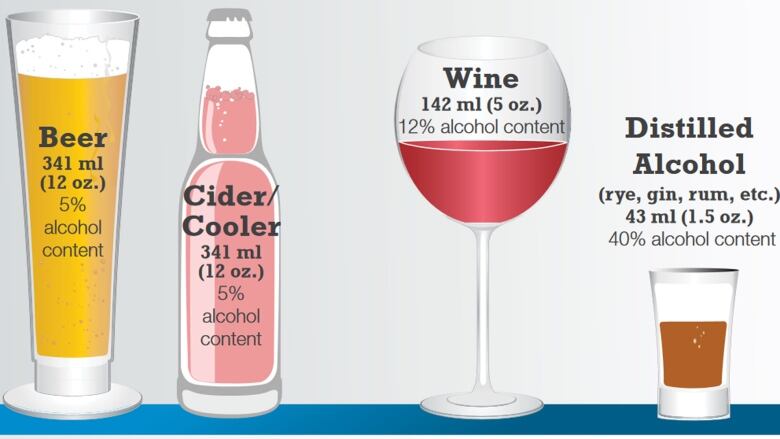Working out could reduce drinking's deadly risks
About 40% of respondents met minimum physical activity guide of 150 minutes of moderate intensity

Move more to drink? Getting the recommended amount of exercise could help offset the higher risk of premature death from drinking alcohol, say researchers who point to the findings as another reason to be physically active.
In 2013, an estimated 22 million Canadians, nearly 80 per cent of the population, drank alcohol in the previous year, according to the Public Health Agency of Canada.
The agency estimates at least 3.1 million drink enough to put themselves at risk of immediate injury or harm. High alcohol intake is also linked to a heightened risk of death from heart disease and several types of cancer.
- Binge drinking by young women raises future health risks
- Pub patrons shrug off new U.K. health warnings about alcohol
But some studies suggest drinking and physical activity may be linked to chronic disease through common but opposite biological pathways. For example, alcohol is thought to cause cancer in a similar way to how physical activity helps prevent it.
The study's first author,Karine Perreault, ofthe School of Public Health of theUniversitde Montral, joked about the motivation for the research.
"Some people would say, like my friends are saying on Facebook, that itwas for personal reasons,"Perreaultsaid.
"Drinking alcohol is part of the Western culture, so we thought thatmaybe it could be just another good reason to be physically active, and wewanted to bring some proof to that hypothesis."

To check into whether physical activity offsets some of the premature mortality risk, researchers turned to data from nationally representative surveys that were done regularly in England and Scotland from 1994 to 2006.
Total weekly alcohol intake was grouped as:
- Neverdrinkerslifetimeabstainers.
- Ex-drinkers previously drank alcohol but had given up for any reason.
- Moderate drinkers up to12standard Canadiandrinks per week for men, up to8for women.
- Hazardous drinkers between12-28standard Canadiandrinks per week for men and between8-20for women.
- Harmful drinkers more than28standard Canadiandrinks per week for men, and over20standard drinks per week for women.
TheCanadian low-risk drinking guidelinesrecommendno more than two drinks a day, 10 per week for women, and three drinks a day, 15 per week for men, with an extra drink allowed on special occasions.
In the study, published in Thursday's online issue of the British Journal of Sports Medicine, about 5,300 respondents or 15 per cent, were lifelong abstainers and former drinkers. Another 4,800 or 13 per cent exceeded the recommended weekly maximum.
Protective effects of physical activity
Over the study period, until 2009 in Scotland and 2011 in England, there were 5,735 deaths among the 36,370 respondents with complete data.
Our results provide an additional argument for the role of physical activity as a means to promote the health of the population even in the presence of other, less healthy, behaviours.-EmmanuelStamatakis
Emmanuel Stamatakis, a professor of exercise, health, and physical activity of the University of Sydney in Australia, and his co-authors found past boozing at hazardous levels were associated with a higher risk of death from all causes.
Being physically active offset some of the mortality risks associated with drinking, they found.Physical activity was defined as walking for any purpose, formal exercise or playing a sport.
Specifically, among those who met the lower and higher recommendations for physical activity, the risk of cancer mortality was weakened or cancelled out, with none of the drinking categories differing substantially from the reference group of never drinkers.
The lower end of recommended physical activity is about 150 minutes per week of moderate intensity physical activity such as shovelling or brisk walking.
'Another good reason to be active'
The physical activity recommendations are the same in Canada,Perreaultsaid.
"The main message is that physical activity is good for your health, evenin the presence of, let's say, non-recommended behaviour like drinkingalcohol. It's just another good reason to be active."
Almost a quarter of respondents said they did no physical activity, andabout 40 per cent did a moderate amount of exercise.
Less than a quarter met the higher, vigorous target such as backpacking at 11 km/h on a five per cent slope carrying 20 kilograms.
As the dose of alcohol intake increase, cancer mortality risk increased in inactive participants but not in those who were physically active.
"The protective effects of physical activity were evident from a level of meeting the minimal public health recommendations,"the authors wrote. "Our results provide an additional argument for the role of physical activity as a means to promote the health of the population even in the presence of other, less healthy, behaviours."
The researchers can't draw cause and effect conclusions from the observational study, which they call the first known look at how physical activity moderates mortality risk with detailed categories of weekly alcohol intake.
Drinking patterns such as binge drinking weren't assessed and dietary factors that could influence the findings may have been missed. It's also possible that drinking and physical activity levels changed over the followup period.
The survey was commissioned by the U.K. Department of Health. The researchers were funded by the National Health and Medical Research Council.












_(720p).jpg)


 OFFICIAL HD MUSIC VIDEO.jpg)
.jpg)



























































































